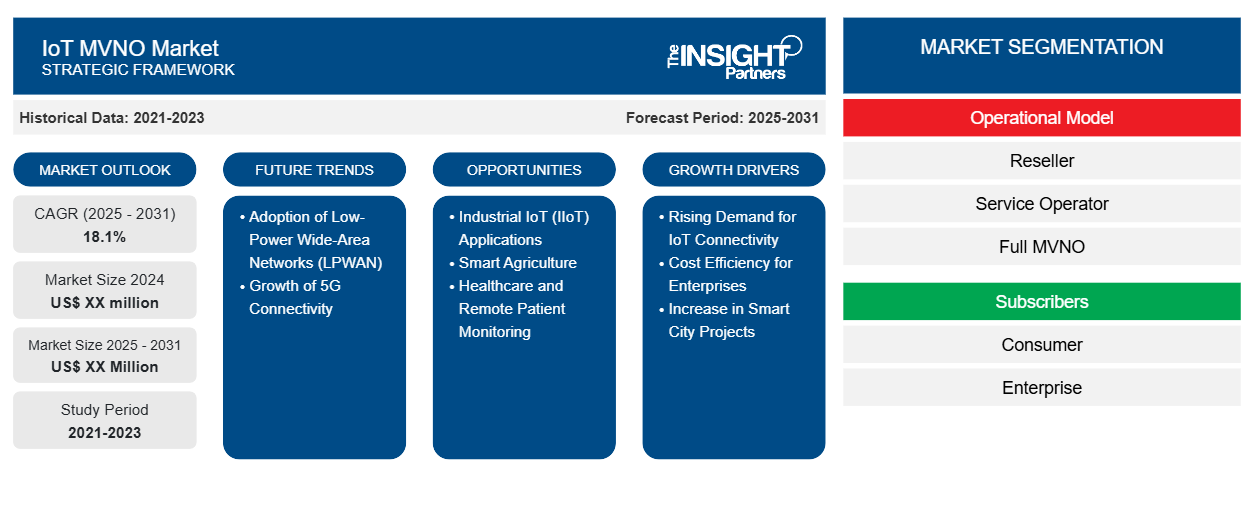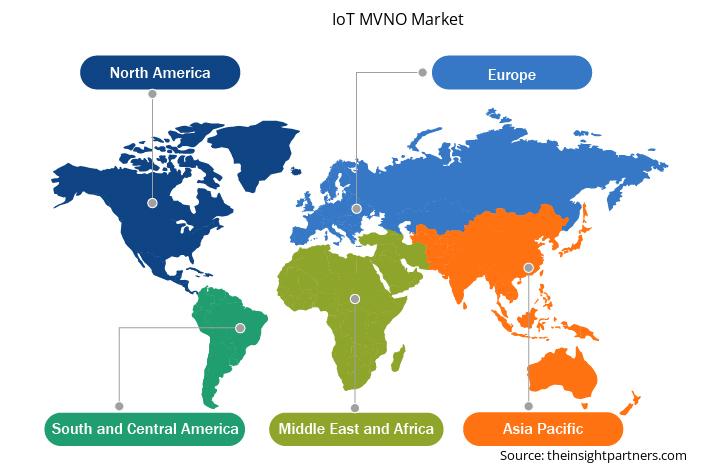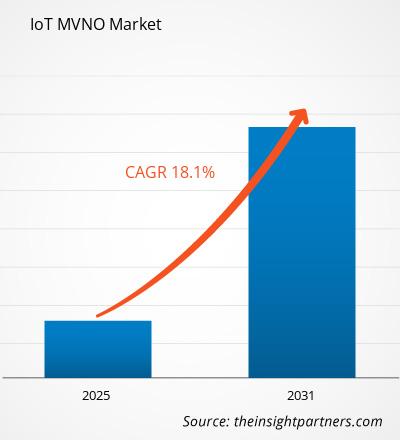Für den IoT-MVNO-Markt wird von 2025 bis 2031 eine durchschnittliche jährliche Wachstumsrate (CAGR) von 18,1 % erwartet, wobei die Marktgröße von XX Millionen US-Dollar im Jahr 2024 auf XX Millionen US-Dollar im Jahr 2031 anwachsen wird.
Der Bericht ist segmentiert nach Betriebsmodell (Wiederverkäufer, Servicebetreiber, Full MVNO), Abonnenten (Verbraucher, Unternehmen) und Unternehmen (Produktion, Transport & Logistik, Gesundheitswesen, Einzelhandel, Landwirtschaft). Die globale Analyse wird weiter nach Regionen und wichtigen Ländern aufgeschlüsselt. Der Bericht bietet den Wert in USD für die oben genannten Analysen und Segmente.
Zweck des Berichts
Der Bericht „IoT MVNO Market“ von The Insight Partners beschreibt die aktuelle Marktsituation und das zukünftige Wachstum sowie die wichtigsten Treiber, Herausforderungen und Chancen. Er liefert Einblicke für verschiedene Geschäftsinteressenten, beispielsweise:
- Technologieanbieter/-hersteller: Um die sich entwickelnde Marktdynamik zu verstehen und die potenziellen Wachstumschancen zu kennen, können sie fundierte strategische Entscheidungen treffen.
- Investoren: Um eine umfassende Trendanalyse hinsichtlich der Marktwachstumsrate, der finanziellen Marktprognosen und der Chancen entlang der Wertschöpfungskette durchzuführen.
- Regulierungsbehörden: Sie regulieren die Richtlinien und polizeilichen Aktivitäten auf dem Markt mit dem Ziel, Missbrauch zu minimieren, das Vertrauen der Anleger zu wahren und die Integrität und Stabilität des Marktes aufrechtzuerhalten.
IoT MVNO-Marktsegmentierung
Betriebsmodell
- Wiederverkäufer
- Dienstbetreiber
- Vollständiger MVNO
Abonnenten
- Verbraucher
- Unternehmen
Unternehmen
- Herstellung
- Transport und Logistik
- Gesundheitspflege
- Einzelhandel
- Landwirtschaft
Geographie
- Nordamerika
- Europa
- Asien-Pazifik
- Naher Osten und Afrika
- Süd- und Mittelamerika
Passen Sie diesen Bericht Ihren Anforderungen an
Sie erhalten kostenlos Anpassungen an jedem Bericht, einschließlich Teilen dieses Berichts oder einer Analyse auf Länderebene, eines Excel-Datenpakets sowie tolle Angebote und Rabatte für Start-ups und Universitäten
IoT-MVNO-Markt: Strategische Einblicke

- Informieren Sie sich über die wichtigsten Markttrends in diesem Bericht.Dieses KOSTENLOSE Beispiel umfasst Datenanalysen, von Markttrends bis hin zu Schätzungen und Prognosen.
Wachstumstreiber auf dem IoT-MVNO-Markt
- Steigende Nachfrage nach IoT-Konnektivität: Mit der branchenübergreifenden Zunahme von IoT-Geräten wächst auch die Nachfrage nach zuverlässigen, skalierbaren und kostengünstigen Konnektivitätslösungen. MVNOs (Mobile Virtual Network Operators), die sich speziell auf IoT-Netzwerke spezialisiert haben, bieten maßgeschneiderte Tarife und Services und fördern so das Marktwachstum, indem sie IoT-Geräteherstellern und Unternehmen Flexibilität und wettbewerbsfähige Preise bieten.
- Kosteneffizienz für Unternehmen: IoT-MVNOs ermöglichen es Unternehmen, die Kosten für Aufbau und Wartung ihrer eigenen Infrastruktur zu senken. Durch die Nutzung bestehender Netzwerke und die Bereitstellung flexibler, kostengünstiger IoT-Konnektivitätspakete bieten MVNOs erhebliche Kostenvorteile, insbesondere für kleine und mittlere Unternehmen, die ihre IoT-Aktivitäten skalieren möchten.
- Zunahme von Smart-City-Projekten: Die zunehmende Verbreitung von Smart-City-Initiativen führt zu einer starken Nachfrage nach IoT-Konnektivität. MVNOs sind hier gut aufgestellt, um Konnektivitätslösungen für Geräte bereitzustellen, die im Infrastrukturmanagement, der Verkehrsüberwachung, der öffentlichen Sicherheit und der Umweltüberwachung eingesetzt werden, und treiben so das Wachstum im IoT-MVNO-Markt voran.
Zukünftige Trends auf dem IoT-MVNO-Markt
- Einführung von Low-Power Wide-Area Networks (LPWAN): LPWAN-Technologien wie LoRaWAN und NB-IoT gewinnen im IoT-MVNO-Markt an Bedeutung, da sie weitreichende, stromsparende und kostengünstige IoT-Konnektivität ermöglichen. Diese Technologien eignen sich ideal für Anwendungen in der Landwirtschaft, der Versorgung und der Logistik und fördern ihre Akzeptanz im IoT-MVNO-Ökosystem.
- Wachstum der 5G-Konnektivität: Mit der Einführung von 5G passen sich IoT-MVNOs an, um ultraschnelle Konnektivität mit geringer Latenz für eine Vielzahl von IoT-Anwendungsfällen bereitzustellen, darunter autonome Fahrzeuge, Smart Cities und industrielle IoT-Anwendungen. 5G ermöglicht IoT-Geräten die Übertragung großer Datenmengen in Echtzeit und eröffnet MVNOs neue Geschäftsmöglichkeiten.
IoT MVNO-Marktchancen
- Anwendungen des industriellen IoT (IIoT): Mit dem Wandel hin zu Automatisierung und datengesteuerten Abläufen bieten IoT-MVNOs die Möglichkeit, spezialisierte Konnektivität für IIoT-Anwendungen bereitzustellen. Dazu gehören Lösungen für vorausschauende Wartung, Lieferkettenüberwachung und Fabrikautomatisierung, die es Unternehmen ermöglichen, ihre Abläufe zu optimieren und Ausfallzeiten zu reduzieren.
- Intelligente Landwirtschaft: Der Agrarsektor setzt zunehmend auf IoT-Lösungen für die Präzisionslandwirtschaft, einschließlich der Überwachung von Bodenbeschaffenheit, Bewässerung und Tiergesundheit. IoT-MVNOs bieten kostengünstige und skalierbare Konnektivität für diese Geräte und unterstützen Landwirte dabei, Technologien einzusetzen, um die Produktivität zu steigern, Kosten zu senken und die Nachhaltigkeit zu verbessern.
- Gesundheitswesen und Patientenfernüberwachung: IoT-MVNOs können die wachsende Nachfrage nach vernetzten Gesundheitsgeräten nutzen, indem sie zuverlässige und sichere Konnektivitätslösungen für Telemedizin, Wearables und Fernüberwachungssysteme anbieten. Diese Dienste ermöglichen es Gesundheitsdienstleistern, insbesondere in abgelegenen und unterversorgten Gebieten eine bessere Patientenversorgung und -betreuung zu gewährleisten.
Regionale Einblicke in den IoT-MVNO-Markt
Die Analysten von Insight Partners haben die regionalen Trends und Faktoren, die den IoT-MVNO-Markt im Prognosezeitraum beeinflussen, ausführlich erläutert. Dieser Abschnitt behandelt außerdem die IoT-MVNO-Marktsegmente und die geografische Lage in Nordamerika, Europa, Asien-Pazifik, dem Nahen Osten und Afrika sowie Süd- und Mittelamerika.IoT MVNO Market throughout the forecast period have been thoroughly explained by the analysts at Insight Partners. This section also discusses IoT MVNO Market segments and geography across North America, Europe, Asia Pacific, Middle East and Africa, and South and Central America.

- Erhalten Sie regionale Daten zum IoT-MVNO-Markt
Umfang des IoT MVNO-Marktberichts
| Berichtsattribut | Details |
|---|---|
| Marktgröße im Jahr 2024 | XX Millionen US-Dollar |
| Marktgröße bis 2031 | XX Millionen US-Dollar |
| Globale CAGR (2025 – 2031) | 18,1 % |
| Historische Daten | 2021-2023 |
| Prognosezeitraum | 2025–2031 |
| Abgedeckte Segmente | Nach Betriebsmodell
|
| Abgedeckte Regionen und Länder | Nordamerika
|
| Marktführer und wichtige Unternehmensprofile |
|
Dichte der IoT-MVNO-Marktakteure: Auswirkungen auf die Geschäftsdynamik
Der IoT-MVNO-Markt wächst rasant. Die steigende Endnutzernachfrage wird durch Faktoren wie veränderte Verbraucherpräferenzen, technologische Fortschritte und ein stärkeres Bewusstsein für die Produktvorteile vorangetrieben. Mit der steigenden Nachfrage erweitern Unternehmen ihr Angebot, entwickeln Innovationen, um den Bedürfnissen der Verbraucher gerecht zu werden, und nutzen neue Trends, was das Marktwachstum weiter ankurbelt.
Die Marktteilnehmerdichte beschreibt die Verteilung der in einem bestimmten Markt oder einer bestimmten Branche tätigen Unternehmen. Sie gibt an, wie viele Wettbewerber (Marktteilnehmer) in einem bestimmten Marktraum im Verhältnis zu dessen Größe oder Gesamtmarktwert präsent sind.
Die wichtigsten Unternehmen auf dem IoT-MVNO-Markt sind:
- KDDI
- KORE Wireless
- Sierra Wireless
- Twilio
- Asahi Net
- Telit
Haftungsausschluss : Die oben aufgeführten Unternehmen sind nicht in einer bestimmten Reihenfolge aufgeführt.

- Überblick über die wichtigsten Akteure auf dem IoT-MVNO-Markt
Wichtige Verkaufsargumente
- Umfassende Abdeckung: Der Bericht deckt die Analyse von Produkten, Diensten, Typen und Endbenutzern des IoT-MVNO-Marktes umfassend ab und bietet eine ganzheitliche Landschaft.
- Expertenanalyse: Der Bericht basiert auf dem umfassenden Verständnis von Branchenexperten und Analysten.
- Aktuelle Informationen: Der Bericht gewährleistet Geschäftsrelevanz durch die Berichterstattung über aktuelle Informationen und Datentrends.
- Anpassungsoptionen: Dieser Bericht kann angepasst werden, um den spezifischen Kundenanforderungen gerecht zu werden und die Geschäftsstrategien optimal anzupassen.
Der Forschungsbericht zum IoT-MVNO-Markt kann daher dazu beitragen, die Branchensituation und die Wachstumsaussichten zu entschlüsseln und zu verstehen. Obwohl es einige berechtigte Bedenken gibt, überwiegen die Vorteile dieses Berichts tendenziell die Nachteile.
- Historische Analyse (2 Jahre), Basisjahr, Prognose (7 Jahre) mit CAGR
- PEST- und SWOT-Analyse
- Marktgröße Wert/Volumen – Global, Regional, Land
- Branchen- und Wettbewerbslandschaft
- Excel-Datensatz
Aktuelle Berichte
Erfahrungsberichte
Grund zum Kauf
- Fundierte Entscheidungsfindung
- Marktdynamik verstehen
- Wettbewerbsanalyse
- Kundeneinblicke
- Marktprognosen
- Risikominimierung
- Strategische Planung
- Investitionsbegründung
- Identifizierung neuer Märkte
- Verbesserung von Marketingstrategien
- Steigerung der Betriebseffizienz
- Anpassung an regulatorische Trends




















 Kostenlose Probe anfordern für - IoT MVNO-Markt
Kostenlose Probe anfordern für - IoT MVNO-Markt